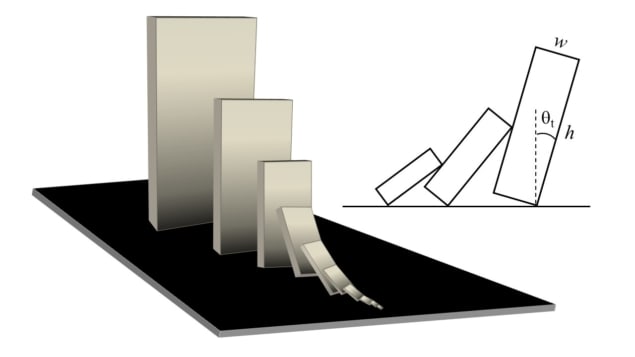Roberto Merlin on explaining the quantum measurement problem, and how a particle distinguishes a Geiger counter from a chair

There is no doubt that something extraordinary happens when a particle interacts with a quantum measuring device (QMD). The venerable “Copenhagen interpretation” says that measurements lead to the probabilistic collapse of the particle’s wavefunction, which, until that point, evolves deterministically according to the Schrödinger equation. But the question of how (or whether) collapses occur cannot be answered within the Copenhagen framework. This is known as the quantum measurement problem, and is the main reason for the enduring interest in “non-Copenhagen interpretations”, ranging from Hugh Everett’s many-worlds theory and hidden-variable explanations like De Broglie–Bohm’s pilot wave, to decoherence, dynamical reduction and quantum-trajectory models.
I had discussed all this many times with my good friend Bob, an amateur science buff. So, when Bob asked me one day: “what’s all the fuss about the measurement problem?” after he had read yet another article on the subject in the popular press, I braced myself. “You physicists like to talk a lot about it, but never explain what a single-particle detector is,” he said, smirking. Unsurprisingly, Bob was not satisfied with my answer involving projection operators and random stuff I recalled from school. “Tell me,” he said, “what is it that distinguishes a measuring from a non-measuring object.” It was right there I realized that I did not have a good understanding of what defines a QMD. Worst of all, I could not even answer Bob’s next question about how a particle distinguishes a Geiger counter from a chair.
I realized I could not answer a question about how a particle distinguishes a Geiger counter from a chair
I did not sleep well that night. I dreamed I was sitting on a huge chair in outer space while being pursued by a neutron. Preparing myself for an elastic collision and associated momentum exchange, I figured that, free of friction, the chair would experience a small change in its velocity that could nevertheless lead to a large modification of its position over a long period of time. I woke up wondering if this made the chair a QMD, and if the elastic interaction would collapse the neutron’s wavefunction. Early the next day, I was at the science library collecting every book I could find on particle detectors.
QMDs are macroscopic systems that can be prepared in non-thermal or thermodynamically unstable states, which are so close to a tipping point that an interaction with a single particle can lead to a massive change, visible to the bare eyes. As Bohr noted in his discussions with Einstein, measurements always involve an irreversible amplification, like an avalanche or chain reaction.

A classical-mechanics example of a chain reaction is the domino sequence pictured, where the distances between dominos and their dimensions grow at a fixed rate α > 1. If a domino can knock down its larger neighbour, falling leads to exponential amplification, since the energy released by the nth domino when it tumbles is a factor of α4(n-1) larger than for the smallest one. The process is irreversible as mechanical energy is dissipated by friction between the dominos. Moreover, if the constant width-to-height ratio is w/h << 1, the energy needed to topple a domino is a factor of (w/h)2 /2 smaller than its gravitational potential energy when standing. Hence, the energy required to initiate the avalanche can be exceedingly small.
But back to QMDs. A literature survey shows that they divide into two main classes, depending on whether the detector’s pointer is initially in a macroscopic state of charge separation or a thermodynamically metastable phase. In the former, a measurement induces a transfer of charge, while in the latter it triggers a phase (or compound) transformation.
The first charge-transfer device to be developed was the Geiger counter, which became a practical instrument in 1928, and is still widely used to detect ionizing radiation. In these devices, individual α, β and γ particles generate charge avalanches when they ionize atoms of an inert gas filling a Geiger–Müller tube. For a brief instant, the electrically insulating gas becomes a conductor and the resulting current pulse signals the detection of a particle. Other charge-transfer devices include photomultipliers, avalanche photodiodes and the silicon detectors used in high-energy experiments.
Phase-transformation QMDs, on the other hand, include photographic plates, which operate by a chain-like chemical reaction, as well as cloud and bubble chambers, developed respectively by Charles Wilson in 1911 and Donald Glaser in 1952. In these chambers, a particle leaves tracks by colliding with and ionizing molecules, which then become nucleation sites for a transformation from an unstable state into a stable one – from supersaturated vapour into liquid droplets in a cloud chamber, and from superheated liquid into gas bubbles in a bubble chamber.
Another example of a phase-transformation QMD is the superconducting-nanowire single-photon detector, first reported by Gregory Gol’tsman and co-workers in 2001. Its key component is a thin, meandering superconducting wire carrying a near-critical current that sets the material at the verge of switching into the normal, non-superconducting state. The phase transition can be triggered locally by the absorption of a single photon.

Thirty years of ‘against measurement’
Armed with the knowledge that the principal trait of a QMD is that it allows a quantum object to generate a chain reaction and, therefore, that a conventional chair could not possibly be a QMD, I arranged to meet Bob for lunch one week after my long day at the library. Of all the things I told him, he was most interested that each measurement increases the entropy of the universe.
“Well done,” Bob said. “You solved the measurement problem.” As I stared in bewilderment, he continued. “If measurements are irreversible, it is abundantly clear that wavefunctions must collapse to prevent the occurrence of superpositions involving states of different entropy.” In what seemed to be a thinly veiled attempt to annoy me, he added, “You surely know that such superpositions violate superselection rules.” I did not know that, and I was very surprised that Bob knew about superselection rules. “By the way,” he said, as I was getting ready to leave, “do you think collapses happened before the 20th century, when detectors were invented?”



